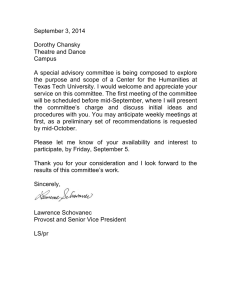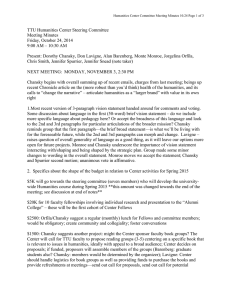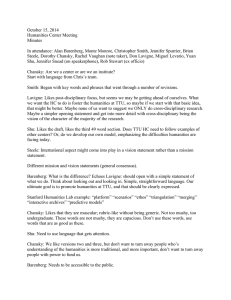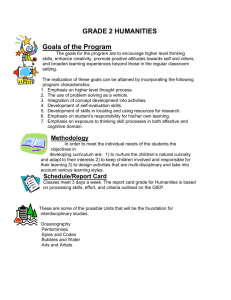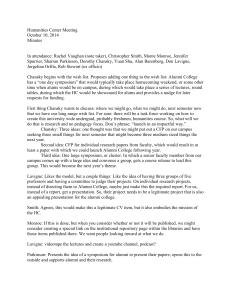October 3, 2014 Humanities Center Meeting
advertisement
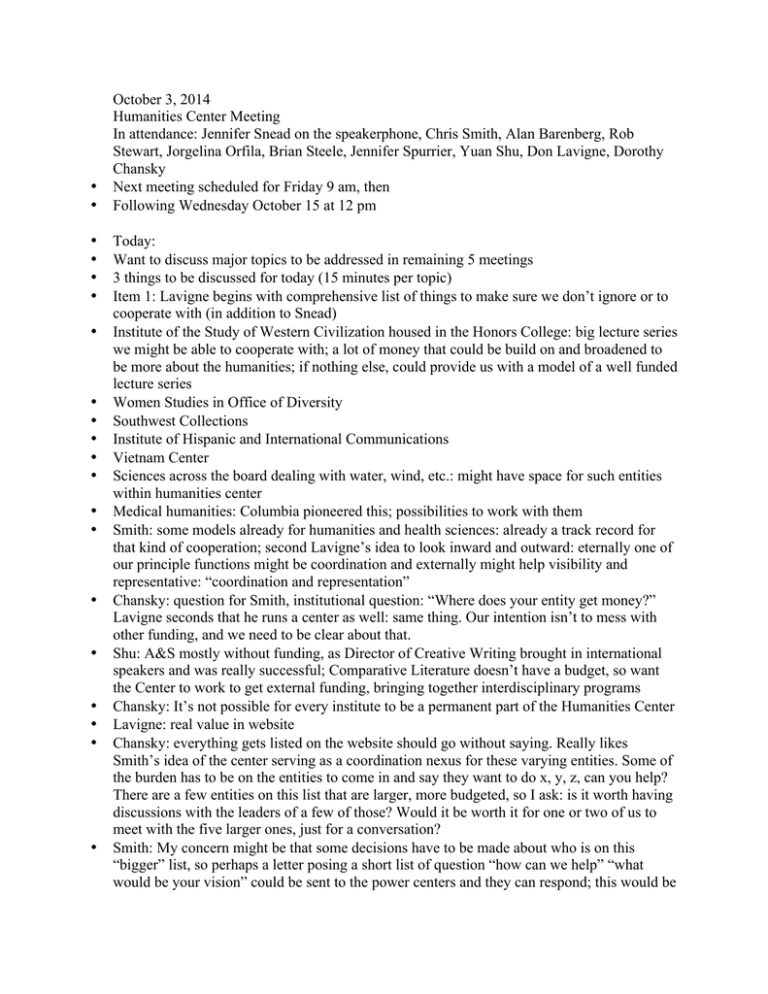
• • • • • • • • • • • • • • • • • • • • October 3, 2014 Humanities Center Meeting In attendance: Jennifer Snead on the speakerphone, Chris Smith, Alan Barenberg, Rob Stewart, Jorgelina Orfila, Brian Steele, Jennifer Spurrier, Yuan Shu, Don Lavigne, Dorothy Chansky Next meeting scheduled for Friday 9 am, then Following Wednesday October 15 at 12 pm Today: Want to discuss major topics to be addressed in remaining 5 meetings 3 things to be discussed for today (15 minutes per topic) Item 1: Lavigne begins with comprehensive list of things to make sure we don’t ignore or to cooperate with (in addition to Snead) Institute of the Study of Western Civilization housed in the Honors College: big lecture series we might be able to cooperate with; a lot of money that could be build on and broadened to be more about the humanities; if nothing else, could provide us with a model of a well funded lecture series Women Studies in Office of Diversity Southwest Collections Institute of Hispanic and International Communications Vietnam Center Sciences across the board dealing with water, wind, etc.: might have space for such entities within humanities center Medical humanities: Columbia pioneered this; possibilities to work with them Smith: some models already for humanities and health sciences: already a track record for that kind of cooperation; second Lavigne’s idea to look inward and outward: eternally one of our principle functions might be coordination and externally might help visibility and representative: “coordination and representation” Chansky: question for Smith, institutional question: “Where does your entity get money?” Lavigne seconds that he runs a center as well: same thing. Our intention isn’t to mess with other funding, and we need to be clear about that. Shu: A&S mostly without funding, as Director of Creative Writing brought in international speakers and was really successful; Comparative Literature doesn’t have a budget, so want the Center to work to get external funding, bringing together interdisciplinary programs Chansky: It’s not possible for every institute to be a permanent part of the Humanities Center Lavigne: real value in website Chansky: everything gets listed on the website should go without saying. Really likes Smith’s idea of the center serving as a coordination nexus for these varying entities. Some of the burden has to be on the entities to come in and say they want to do x, y, z, can you help? There are a few entities on this list that are larger, more budgeted, so I ask: is it worth having discussions with the leaders of a few of those? Would it be worth it for one or two of us to meet with the five larger ones, just for a conversation? Smith: My concern might be that some decisions have to be made about who is on this “bigger” list, so perhaps a letter posing a short list of question “how can we help” “what would be your vision” could be sent to the power centers and they can respond; this would be • • • • • • • • • • • • • • • • • • a little less selective. Produce documents that people have thought about. Can shape it by having a short list of questions. Orfila: still should define the Humanities Center. Stewart: Keeping the initial meeting relatively informal would be something to consider to allow more free thinking. Not to say that questions can’t be posed, but that maybe not to be answered in writing so they don’t feel as if they’re being assessed. Chansky: While we don’t know what the Center is yet, do we have a problem sharing the wish list? Everyone agrees. Chansky assigns Lavigne to these meetings. Item 2: Steele sharing his number gathering concerning the proposed university wide freshmen humanities class Large classes with 500 students each (we will eventually need more than 11 classes) Handout outlining numbers of students and instructors needed Model 1 and 2 work with idea of elite instructor bringing in other faculty, in 1 guest instructors coming in for guest lectures, model 2 has TAs, model 3 uses team teaching with TAs Problem: departments would have to add 3 hours Stewart: How could this FIT? Physically and curricularly. One approach that might be feasible is to see about getting the course into core curriculum for language and philosophy component so that it fits into the degree components. It would be codified into the core curriculum and begin to gain a following based on selection rather than requirement. Would get better buy-in with this. Shu: On one hand, for English 2000 level courses are fine, but junior and senior courses enrollment has gone done. So, how the nature of the course would fit into the curriculum? To satisfy core curriculum, it has to be 1000 or 2000 level course Lavigne: doesn’t believe work is worth it with the gradual approach Chansky: Big idea behind this still that faculty rather than TAs would teach this, freshmen exposed to senior faculty. Smith: Question: Is it possible that we could think about a variation or hybridity in the delivery method? Does it have to be all bodies in a physical space at the same time? Is it possible that if we design a hybrid course that it would be more feasible to launch? If we design something like that, I would like to make some observations about what has worked and hasn’t worked in online classes. Example: if you want a shared experience, it needs to happen in real time with professor talking on screen. Feasible, rooms on campus we could deliver that. Second: if we did that, perhaps if we designed a course that was hybrid or online, it allows Tech students not on campus and commuting students to attend, and also allows for the possibility of AP credit, and finally speaks to some of our previous philosophical questions on how do with deal with a more cutting edge identity for the humanities? Orfila: difficult for professors not familiar with the media Snead: online teaching in ENGL, require a synchronous element in online classes. We have to have the real time element, but it does work. Barenberg: Highly ambivalent about online teaching, especially with humanities. On one hand, with whole campus this might be the only possibility. Buy in would increase with • • • • • • • • • • • • • • • • • • • • • • online campus: attractive option. But, we must be careful, because if we fail it would defeat the whole purpose. Chansky: met with Stewart and there’s a real possibility we could have this class up and running the year after next. Going with what Rob said about letting people self select at first and generating energy and buy in is to start the class in that manner. See if 300 kids want to take it. Do this for a couple years, see how it’s working, then revisit it and maybe take it to the next level: in person or hybrid level? Don is right, student might balk at the idea, and this is the cost. Lavigne: multicultural? Chansky: rig this so it could satisfy either one Snead: is teaching a cross listed course in women studies, so how about this option? Might be a way to get departmental buy in. Chansky: this is a good idea, problem might be if everyone said they were taking it as an ENGL course, then humanities option wouldn’t exist. Stewart: Shouldn’t write it off, but this might be a way to get this out there and legitimize it. Caution: anything that comes out of this: if it looks like the proposal is that there is a new requirement of incoming freshmen, than there will be push back from departments that don’t know how to fit this into their degree plan. Need to have these parameters in mind. Chansky: suggest that we put this into our report that’s going to the provost by thanksgiving, and that we consider using a part of the 50K from the provost to pay a small group of us to actually hammer this out during next semester as its own free standing project. Everyone concurs. Orfila: interdisciplinary humanities: make sure we include this term. Item 3: word-crafting of Smith Chansky: this is elevator speech, we should have two more paragraphs expanding on this. Shu: We need something aiming toward international students. Objective is to engage issues of national and global concerns rather than just “promote critical thinking.” We should think of an objective higher than that that speaks to the global level. Orfila: Likes the idea of transdisciplinarity, the idea that it’s not just to reinforce boundaries of your own discipline, but also to engage with the other. Why inTRAdisciplinary? Might be more effective? Within the humanities? We all thought he meant “inter” We would perhaps prefer “transdisciplinary.” Notion of humanism is part of our concern and discussion. Reimagining the humanities within a post-humanistic democratic society (Bruce’s email) We don’t think we need “post-human” in our mission statement. In third paragraph, sure, but not mission statement. Snead: Also has to have tie-ins with digital term in the humanities. Smith: Is there a possibility that we might be able to use the term “post disciplinary engagement?” Moves the goal posts a little, speaks to Clarke’s idea with post-humanism. Stewart: Question: What does “post disciplinary engagement” mean? Maybe not use it as an adjective? Smith: What is humanities in the 21st century and how is different from what it’s been? Chansky: Does have to talk to the outside world. • • • • • • • Shu: the point is that it’s ambiguous. We anticipate and want people to ask “what is it?” beginning critical engagement. Jorgelina, Yuan, and Chris to get together and look over the mission statement. For next time: Ready to begin to think about a bit of a road map. What are we thinking might happen sooner rather than later, what might happen later? Orfila: thinking about other sources, so assigned to send Chansky the link of other sources to peruse. Brian: on mission statement should we mention something about pedagogical issues? Does this fit with the mission statement? Shu: should be above looking over all the humanities, so mission statement should achieve that effect rather than (Smith’s language following) incorporating language which attempts to lay out entire menu of what center hopes to provide
